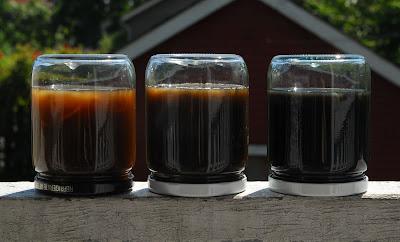
Linen has to be my favourite plant fibre for zillions of reasons and for years I have been in awe with this wonderful
bast fibre. The tiny flax seeds will grow into long stalks of up to 1.5 meters with beautiful blue, violet or white flowers that will follow the sun's direction and close up at night. What I revere the most though is the devotion one gives to the processing by hand of such fibre before it can be spun into linen threads.
When ready, the plants need to be collected and hung to dry. Next the seeds are removed - a step called "
rippling" - and saved for next year's crop. After the stalks are rippled, they are bundled and prepared for "
retting" - a rotting process that breaks the outer coating of the plants.
Once the retting is done the fibres are dried again before the stalks are first broken to separate the bast fibres from the inner core of the plants, and then scraped to remove the remaining straw off the stalks - a process called
"scutching". The breaking can be done by hand, though a tool such as the "
flax brake" quickly becomes handy, while the scutching is done with a wooden knife and scraper. One last step before the fibres are spinnable and that is "
hackling" - the combing of the fibres through finer and finer hackles (different sizes of comb). The hackling process releases the spinnable fibres and it usually takes several passes to produce a good spinning fibre.

I don't know too many people who grow flax themselves - let alone spin it into linen. A few years ago, I came across
The Linen Project - a regional initiative in Victoria - now regrouped under
Flax to Linen. It was then that I scutched and hackled
some fibres while getting a better understanding of what it really means
to process bast fibres.
More recently, I was delighted to meet Julia Ostertag, PhD candidate at UBC. As part of her research project, Julia grew flax this past season, processed it into striks and learned to spin her own linen. Julia's devotion to her bast fibre is inspirational and I am pleased that she invited me to assist her with her spinning and workshop. It is not every day that one gets to spin local flax into linen - it is rather an honour!
The spinning is part of Julia's research - "an art and garden-based exploration into the history and contemporary practices of school gardening to better understand the relationships between land and teaching".
The public is invited to view Julia's installation and participate in her research process. To read more about Julia's project visit
The Orchard Garden.
 Speaking of the Crawl, it's been a pleasure for a second time around to display some of my weaving along with Stu's work at Beatty Street Woodworkers. We both enjoy playing with the characters of our chosen medium to create one-of-a-kind pieces.
Speaking of the Crawl, it's been a pleasure for a second time around to display some of my weaving along with Stu's work at Beatty Street Woodworkers. We both enjoy playing with the characters of our chosen medium to create one-of-a-kind pieces.  This year, Stu also displayed some benches - all of them made of re-purposed timber but offering different lines, shapes, lengths and types of wood. Each one is unique and combines ingenuity in design and craftsmanship.
This year, Stu also displayed some benches - all of them made of re-purposed timber but offering different lines, shapes, lengths and types of wood. Each one is unique and combines ingenuity in design and craftsmanship.
 The "grand" bench of them all is made of western red cedar. The legs - offset and angled forwards - capture the attention as a design element, while the claro and black walnut bring contrast to the bench (details on left photo).
The "grand" bench of them all is made of western red cedar. The legs - offset and angled forwards - capture the attention as a design element, while the claro and black walnut bring contrast to the bench (details on left photo).















